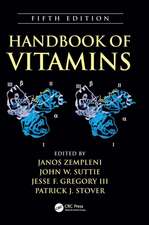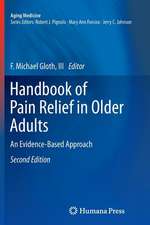Perioperative Hemodynamic Monitoring and Goal Directed Therapy: From Theory to Practice
Editat de Maxime Cannesson, Rupert Pearseen Limba Engleză Hardback – 3 sep 2014
Preț: 781.79 lei
Preț vechi: 822.94 lei
-5% Nou
Puncte Express: 1173
Preț estimativ în valută:
149.64€ • 162.60$ • 125.78£
149.64€ • 162.60$ • 125.78£
Carte tipărită la comandă
Livrare economică 21 aprilie-05 mai
Preluare comenzi: 021 569.72.76
Specificații
ISBN-13: 9781107048171
ISBN-10: 1107048176
Pagini: 297
Ilustrații: 71 b/w illus. 10 tables
Dimensiuni: 194 x 252 x 15 mm
Greutate: 0.79 kg
Ediția:New.
Editura: Cambridge University Press
Colecția Cambridge University Press
Locul publicării:New York, United States
ISBN-10: 1107048176
Pagini: 297
Ilustrații: 71 b/w illus. 10 tables
Dimensiuni: 194 x 252 x 15 mm
Greutate: 0.79 kg
Ediția:New.
Editura: Cambridge University Press
Colecția Cambridge University Press
Locul publicării:New York, United States
Cuprins
Preface; Foreword Emanuel P. Rivers; Part I. Surgery and Critical Care: Epidemiology and Public Health Approach: 1. Patient outcome following major surgery Elisa Kam and Rupert Pearse; 2. Statistical methods in hemodynamic research Yannick Le Manach and Gary Colins; 3. New trends in perioperative medicine Gautam Kumar, David Walker and Michael Mythen; 4. The surgical home: a paradigm shift toward perioperative practice Shermeen B. Vakharia, Zeev N. Kain and Leslie M. Garson; Part II. Cardiovascular Physiology Applied to the Perioperative and Critical Care Settings: 5. Overview of the circulation Michael R. Pinsky; 6. Cardiac function and myocardial perfusion Jason H. Chua, Rudolph Nguyen and Aman Mahajan; 7. Blood pressure regulation Sheldon Magder; 8. Microcirculation and mitochondrial dysfunction Daniel De Backer and Diego Orbegozo Cortes; 9. Hemoglobin function and patient blood management Aryeh Shander, Faraz Syed and Mazyar Javidroozi; 10. A rational approach to fluid and volume management Daniel Chappell and Matthias Jacob; 11. Vasopressors and inotropes Robert H. Thiele and James M. Isbell; 12. Cardiovascular physiology applied to critical care and anesthesia Nils Siegenthaler and Karim Bendjelid; Part III. Hemodynamic Monitoring in the Perioperative Environment: 13. Integrative approach for hemodynamic monitoring Christoph K. Hofer, Steffen Rex and Michael T. Ganter; 14. Evaluation of a cardiac output monitor Lester Augustus Hall Critchley; 15. Invasive hemodynamic monitoring systems Paul E. Marik; 16. Semi-invasive and non-invasive hemodynamic monitoring systems Cédric Carrié, Mathieu Série and Matthieu Biais; 17. Mean systemic pressure monitoring Michael R. Pinsky; 18. Fluid responsiveness assessment Xavier Monnet and Jean-Louis Teboul; 19. Non-invasive and continuous arterial pressure monitoring Berthold Bein and Christoph Ilies; 20. Monitoring the microcirculation Daniel De Backer and Katia Donadello; 21. ScvO2 monitoring Alice Carter and Rupert Pearse; Part IV. Goal Directed Hemodynamic Optimization: 22. Goal directed therapy in the intensive care and emergency settings: what is the evidence? Joseph Meltzer; 23. Goal directed therapy in the perioperative setting: what is the evidence? Eric Edison and Andrew Rhodes; 24. Endpoints of goal directed therapy in the OR and in the ICU Nathan H. Waldron, Timothy E. Miller and Tong J. Gan; 25. What is a fluid challenge and how to perform it? Maurizio Cecconi; 26. The relationship between anesthesia, hemodynamics and outcome Tom Abbott and Gareth L. Ackland; 27. Goal directed fluid and hemodynamic therapy in cardiac surgical patients Byron D. Feregerson and Gerard R. Manecke, Jr; 28. Goal directed therapy and hemodynamic optimization in the critical care setting: practical applications and benefits Trung Vu, Davinder Ramsingh, William Wilson and Maxime Cannesson; 29. Goal directed therapy at the bedside: the nurse perspective Elizabeth J. Bridges and Debra R. Metter; 30. A nurse anesthetist perspective: does perioperative goal directed fluid management yield better patient outcomes compared to the traditional method? Ann B. Singleton; 31. How to implement GDT in an institution and at the national level Timothy E. Miller and Michael Mythen; 32. Decision support and closed-loop systems for hemodynamic optimization and fluid management Joseph Rinehart; Index.
Recenzii
'This is a useful book for the medical professional looking at implementing goal-directed therapy in their perioperative care pathway in a period when more and more national societies are promoting this approach in their guidelines.' B. F. Geerts, Netherlands Journal of Critical Care
Descriere
Provides a comprehensive understanding of perioperative hemodynamic monitoring and goal directed therapy, emphasizing practical guidance for implementation at the bedside.








